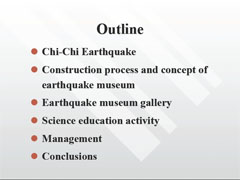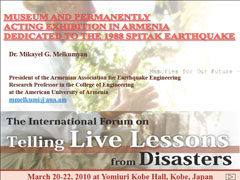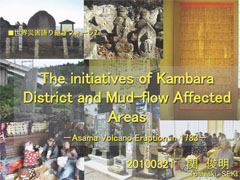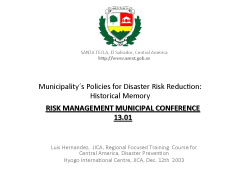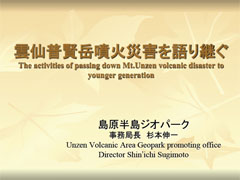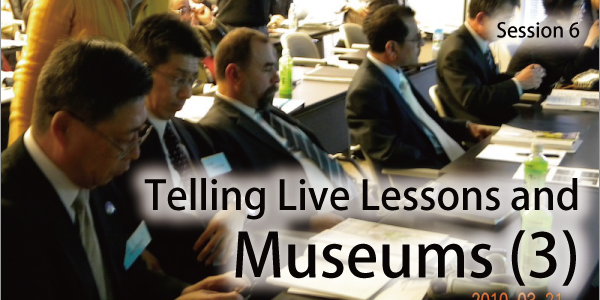
Coordinator
Nobue Funaki
Lecturer, Kobe Gakuin University
Institute of Multi-Disciplinary Education
Section of Disaster Management and Social Service
Biography
B.E. in Humanity and Science (1999) from Kobe Gakuin
University and Master of Education counseling (2001) from
Northern Arizona University in the US, worked in The Great
Hanshin-Awaji Earthquake Memorial Disaster Reduction and
Human Renovation Institution (2002-2003), and take a
doctor’s course (2003-2006). At the present position since
2006. Research topic: Disaster mitigation education(To
research about present condition of disaster mitigation
education in school and provide/create educational program
to teacher)
Coordinator
Seiji Suwa
Environment and Disaster Mitigation Course chairman and teacher at Maiko High School, Hyogo Prefecture
Biography
B.E. in Education (1982) from Okayama University, worked in
Kobe commercial high school(1982-1994) and Maiko high school
(1994-present). The environment and disaster mitigation
course started at Maiko High School in April 2002
(Environment and Disaster Mitigation Coursechairman:
2002-present). The purpose to start the environment and disaster mitigation course is to send the lssons we learned from the
Great Hanshin-Awaji Disaster to the world and make the citizens aware and prepared to cope with disasters. The literacy consists of three factors:
the fundamental knowlege and the fundamental skills to cope with the disasters, and the strong will to contribute to the society.
Link
Maiko High School>
Earthquake, Taiwan, 1999
Taiwan is located at the Eurasian plate and Philippine Sea
plate on the suture zone. The Taipei weather seismograph was
installed in the beginning of the Japanese occupation period
in 1897. Up until 2009, Taiwan has encountered ten major
earthquakes.
The Chi-Chi Earthquake in 1999 (also called 921 earthquake), brought more loss and damage of life and property than most significant earthquakes over a hundred years. The 921 Earthquake Museum of Taiwan has several missions, including commemoration of the earthquake, reflection of the earthquake, education of earthquake science and disaster prevention, preservation of the disastrous site, and collections of relics, documents, and historical facts of the earthquake.
In order to achieve these goals, several buildings have
been established. One building houses and preserves a real
fault line, named the Chelungpu Fault Gallery. Moreover,
Earthquake Engineering Gallery, Imaging Gallery, Disaster
Prevention Gallery and Reconstruction Gallery were also
built.
On another level, the museum has a goal to progressively enrich the awareness of earthquakes by employing scientific and disaster prevention education in the way of special exhibitions and hands-on exercises and activities. The 921 Earthquake Museum actively promotes its vision in Taiwan and the world to implement the concept of disaster prevention and disaster relief to save lives and enhance our community’s capacity to respond to future earthquakes.
Der-Chyi Wu
Director, 921 Earthquake Museum of Taiwan
Biography
(explanation)
Link
Museum's
website
Earthquake, Armenia, 1988
Armenian Association for Earthquake Engineering (AAEE) was
established in 1998 and was registered by the Ministry of
Justice of Armenia in 1999. In the year 2000 AAEE became a
member of IAEE and in 2002 a member of EAEE. The first large
project of AAEE was the establishment of a Museum and a
permanently acting Exhibition on the achievements in the
field of earthquake engineering in November 2002. The
destructive consequences of the 1988 Spitak Earthquake are
well known ? more than 25,000 people killed and more than
500,000 people remained homeless. Thus, it is necessary
first to always remember what had happened and who had
extended help to Armenia for reconstruction of the
Earthquake Zone, and second to draw lessons, as well as to
educate the population for acquisition and further
improvement of its seismic literacy.
The happened tragedy showed that underestimation of this inescapable natural phenomenon leads to consequences, which turn back the development of the country for decades. This takes place, when the world experience in assessment of seismic hazard and risk and protection against it is ignored. Every member of the society should know what kind of hazard is in store for him and how he can help himself and others in case of an earthquake. By creating his dwelling or his working place without the necessary base of knowledge, a person exposes himself and others, as well as his progeny, to a mortal danger conditioned by forthcoming earthquakes. One should not live for the day only and think, that the earthquake would hit somewhere far away from him. Because of lack of education in the areas of earthquake engineering and disaster management people continue to build their habitation in absolutely inadequate ways towards the real seismic hazard. The Museum and Exhibition became a source of knowledge, education and information for people from various strata of society and of different ages.
Mikayel G. Melkumyan
President, Armenian Association for Earthquake Engineering; Research Professor, American University of Armenia
Biography
Mikayel Melkumyan is a Doctor of Engineering Sciences. He is
a Research Professor in the College of Engineering at the
American University of Armenia. In 1990-1991 he conducted
joint scientific-research work in the laboratory of
Professor Okada in the Institute of Industrial Science
(IIS), University of Tokyo, Japan. Since 1990 he is a
Foreign member of the Research Center of Seismic Resistant
Structures of IIS. In 1995-1996 he developed 2 unique
methods of upgrading earthquake resistance of existing
buildings without interruption of the use of the buildings
by means of base isolation and isolated upper floor (his
method on retrofitting by base isolation has already been
implemented in Armenia and Russia and retrofitting design
developed by him has been submitted for implementation in
Romania). Since 1997 he is the Vice-President of the
International Association of CIS Countries on Base
Isolation. Since 1998 he is the President of the Armenian
Association for Earthquake Engineering and since 2001 he is
a Founding Member of the Anti-Seismic Systems International
Society (ASSISi). Also he is a Member of the European
Association for Structural Dynamics, a Corresponding Member
of the Armenian Academy of Engineering, a Member of the
European Association for the Control of Structures, a
Supporting member of the International Council for Research
and Innovation in Building and Construction (CIB) Working
Commission WC114 “Earthquake Engineering and Buildings”, a
Supporting member of the CIB Task Group TG75 “Engineering
Studies on Traditional Constructions”, the Chairman of the
TC 7 (CEN/TC 340) “Anti-seismic devices” Armenian National
Technical Commission under the same name European Committee
for Standardization CEN/TC 340. Mikayel Melkumyan is
author/co-author of more than 170 scientific papers,
including 12 books and 12 inventions/patents.
Volcano, Mt. Asama, 1783
The Kanbara Kan-non-do Temple tells the tragedy of “15 steps that made the difference between life and death in the Tenmei Era.” Excavations started in 1979 brought back part of the village of Kanbara of 1783. The village was buried in 6 m of mud from the eruption of Mt. Asama, which killed 477 people. Nevertheless, with the help of neighboring villages, the 93 people who escaped to Kan-non-do Temple and other places on high ground rebuilt a new green-rich village on top of the former village where their ancestors slept. The mudflows swallowed the basin between the Agatsuma River and Tone River, claiming the lives of 1,490 persons in 37 villages. For the ensuing two centuries, the locals have continued to talk about the disaster and recovery without ever forgetting. I will introduce an example of a memorial service in the Kanbara area and a few points in the mudflow disaster zone, and confirm elements of a community that has preserved its disaster history and elaborate on a vision of mine.
Toshiaki Seki
Teacher, Higashi Elementary School, Tsumakoi Village, Gunma Prefecture; Ex Specialist, Berried Cultural Properties Research Agency
Biography
Toshiaki Seki was involved with the 1783 Asama Eruption via
excavations into sites in the disaster area. As a resident
of the said area, he is interested in developing a vision of
an outdoor museum for passing down events of the past
(tentative name: “Japan’s Pompei”). 1996- 2005: Worked for
the Gunma Archeological Research Foundation. 2002:
Participated in the 10th excavations of Pompei, Italy by the
Paleological Association of Japan. 2004-05: Member of the
“Expert Panel on Passing Down Disaster Lessons” of the
Central Disaster Prevention Council, Cabinet Office; Member
of the Japan Archeological Association; Member of the Local
History Research Association.
Link
1783 Mt. Asama Eruption”, Report of the Expert Panel on
Passing-down Disaster Lessons, Central Disaster Prevention Council, March 2006
Map of the Remains of the 1783 eruption and mud flow 1
Map of the Remains of the 1783 eruption and mud flow 2
Tsumagoi Museum, Map of the mud flow of 5 August 1783
El Salvador Earthquake: 2001
Luis Roberto Hernandez Osegueda
General Manager, Santa Tecla Municipality
Biography
view here
Volcanic Eruption of Unzen-Fugen: 1991
The truth of the disaster and the activities of victims are recording from a sense view of the inhabitants. The activities owned jointly with case studies of other volcano for example, Usu Volcano and Miyake-jima Volcano is doing. The activities passed down the experience to younger generation are continuing until now passed twenty years from the eruption. I was doing the activities passed down to visitors and students visited on a school excursion.
Shin'ichi Sugimoto
Director, Unzen Volcanic Area Geopark Promoting Office
Biography
(explanation)
Copyright c 2011 TeLL-Net
All Rights Reserved.
